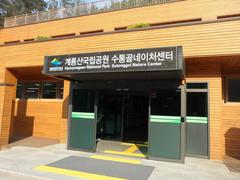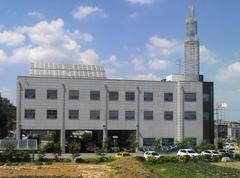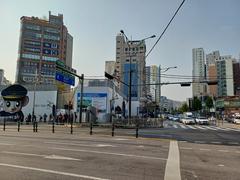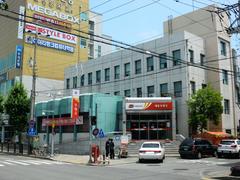Government Complex Sejong Visiting Hours, Tickets, and Travel Guide
Date: 15/06/2025
Introduction
The Government Complex Sejong stands at the heart of Sejong City, South Korea, as a monumental achievement in the nation’s decentralization and balanced regional development strategy. Envisioned in the early 2000s and realized through an international design competition in 2008, this vast administrative complex spans 667 acres, houses over 37 government agencies, and employs approximately 13,000 public officials. Its design departs from traditional vertical government buildings, instead favoring a horizontally interconnected structure that symbolizes openness, sustainability, and cultural continuity. The world’s longest rooftop garden and zero-waste principles exemplify South Korea’s commitment to ecological harmony and democratic unity. Visitors can explore administrative spaces, exhibition areas, rooftop parks, and cultural centers that showcase Korea’s innovative approach to governance and urban living.
For updates and more details, consult the Sejong City official tourism website, urbanNext, and the Government Buildings Management Office.
Table of Contents
- Introduction and Significance
- Historical Context and Purpose
- Core Administrative Functions
- Urban Design and Symbolic Significance
- Role in National Development and Decentralization
- Visiting Hours, Tickets, and Accessibility
- Transportation and Getting There
- Visitor Amenities and Accessibility
- Special Events and Photographic Spots
- Nearby Attractions and Travel Tips
- Frequently Asked Questions (FAQ)
- Conclusion and Call to Action
- References and Further Reading
Historical Context and Purpose
Government Complex Sejong was conceived to address the overconcentration of administrative and economic activities in Seoul. Its establishment is central to South Korea’s efforts to decentralize governance and promote balanced regional growth. Officially opened in 2012, the complex has since become home to 40 central administrative agencies and 15 national R&D institutes, making it the administrative nucleus of the country (Sejong City Official).
The Sejong master plan, developed by Balmori Associates, H Architecture, and Haeahn Architecture, envisioned a continuous architectural structure that physically and symbolically unites various ministries. The project reflects the nation’s broader vision of transparency, accessibility, and interdepartmental collaboration (urbanNext).
Core Administrative Functions
Centralization of National Governance:
Government Complex Sejong houses a majority of South Korea’s central ministries, such as the Ministry of Economy and Finance, Ministry of Education, and Ministry of Land, Infrastructure and Transport (Ministry of Economy and Finance). The proximity of these agencies streamlines policy development, economic planning, and cross-ministerial collaboration, enhancing administrative efficiency and fostering cooperation (Sejong City Official).
National Research and Innovation Hub:
With 15 national R&D institutes relocated to Sejong, the city serves as a nexus for evidence-based policymaking and innovation. The joint campus model integrates industry, academia, and government, supporting large-scale educational and research projects.
Presidential and Executive Functions:
Sejong’s role as the executive capital is expanding, with phased plans for a Sejong Office of the President slated through 2025. This development aims to further consolidate government operations outside Seoul and enhance presidential oversight (Namu Wiki).
Urban Design and Symbolic Significance
Architectural Vision
The Government Complex Sejong is a landmark of contemporary architecture and urban planning. The master plan covers 667 acres and features an extensive linear rooftop park—the world’s longest—connecting 15 low-rise buildings (urbanNext). The design’s core concepts include:
- Flat City: Horizontal continuity symbolizes democratic unity.
- Link City: Seamless integration between government facilities, public spaces, and nature.
- Zero Waste City: Waste from one system becomes input for another, reflecting sustainability at every level.
This rooftop park—the “fifth façade”—is a communal space visible from across Sejong, blurring the lines between officialdom and daily life.
Symbolic Geography
The complex’s location, chosen for its auspicious geomancy, is surrounded by mountains and rivers believed to bring prosperity and harmony (Korea JoongAng Daily). Its aerial silhouette, reminiscent of an Oriental dragon, conveys strength and prosperity.
Role in National Development and Decentralization
Balanced Regional Growth
A core motivation for Sejong’s creation was to relieve Seoul’s population and resource pressure, stimulating economic and social development in central South Korea. The relocation of ministries and R&D institutions has spurred new infrastructure, housing, and educational facilities (Government Buildings Management Office).
Administrative Efficiency
Colocating ministries in a single, interconnected campus enables faster decision-making, simultaneous handling of diverse functions, and real-time collaboration through advanced IT and transportation systems (Sejong City Official).
Future Expansion and Cultural Integration
Future plans include a national library, art center, museum complex, presidential archive, and healthcare facilities. The upcoming National Museum Complex will host museums dedicated to architecture, design, digital heritage, and more, integrating culture, learning, and administration (Landezine).
Visiting Hours, Tickets, and Accessibility
- Opening Hours: Monday–Friday, 9:00 AM–6:00 PM. Closed on weekends and public holidays. The rooftop park is open daily from 7:00 AM–10:00 PM.
- Tickets: Entry to public areas, the rooftop garden, and most exhibition spaces is free.
- Guided Tours: Available by advance reservation through the Sejong City tourism website. Some special exhibitions or group tours may require booking and a nominal fee.
- Accessibility: Ramps, elevators, tactile paving, wheelchair rentals, and accessible restrooms are provided. The complex’s barrier-free design ensures inclusivity for all visitors.
Transportation and Getting There
- By Bus: Frequent intercity buses connect Sejong to Seoul and Daejeon.
- By Train: Take the KTX to Osong Station, then transfer by local bus or taxi (approx. 20 minutes).
- By Car: Ample parking is available for both surface and underground vehicles.
- From Incheon International Airport: Direct airport limousine buses are available (approx. 2.5 hours).
- Cycling: Dedicated bike lanes and rental stations; the flat terrain is ideal for cyclists.
For detailed transit options, visit the official Sejong City transportation portal.
Visitor Amenities and Accessibility
- Information Centers: Multilingual staff offer assistance, bookings, and directions.
- Wi-Fi: Free throughout the complex.
- Dining: Cafes, cafeterias, and convenience stores are located on-site.
- Restrooms: Clean, accessible, and distributed throughout the campus.
- Shops: Gift shops offer souvenirs themed around King Sejong and Korean governance.
- Security: Strict entrance checks; emergency services and first aid stations are available.
Special Events and Photographic Spots
The complex hosts cultural events, exhibitions, and national ceremonies, especially on holidays and commemorations of King Sejong. The Grand Memorial Hall, eco-friendly rooftop gardens, and striking glass facades are top photographic spots. For event schedules and exhibitions, check the official Sejong City website.
Nearby Attractions and Travel Tips
Attractions:
- Sejong National Library: Modern architecture, panoramic rooftop views.
- Sejong Lake Park: Ideal for walks and picnics.
- Sejong National Arboretum: Features over 1,000 plant species.
Travel Tips:
- Visit in spring or autumn for the best weather.
- Wear comfortable shoes due to the complex’s size.
- Modest attire is recommended in official or memorial zones.
- Observe posted signs for photography restrictions.
- Download the Audiala app for maps and audio guides.
Frequently Asked Questions (FAQ)
Q: Is there an entrance fee?
A: No, admission to public areas and the rooftop garden is free. Some special exhibitions or guided tours may require advance booking.
Q: What are the visiting hours?
A: Monday–Friday, 9:00 AM–6:00 PM for most facilities; rooftop park open daily 7:00 AM–10:00 PM.
Q: Is the complex accessible for visitors with disabilities?
A: Yes, barrier-free design, ramps, elevators, accessible restrooms, and assistance services are provided.
Q: Are guided tours available in English?
A: Yes, tours are offered in Korean and English. Audio guides and materials are available in other languages.
Q: Can I take photographs?
A: Photography is allowed in public areas, but may be restricted in sensitive zones. Always follow posted guidelines.
Q: How do I get there from Seoul or Incheon Airport?
A: KTX train to Osong + bus/taxi, or direct airport limousine bus from Incheon.
Conclusion and Call to Action
Government Complex Sejong is a living testament to South Korea’s vision for sustainable, decentralized governance and innovative urban planning. Its inclusive design, cultural amenities, and public spaces make it both an administrative powerhouse and a vibrant destination for visitors. Whether you are interested in architecture, policy, or culture, Sejong offers a unique, enriching experience.
Plan your visit today:
- Download the Audiala app for maps, guides, and real-time updates.
- Check the Sejong City tourism website for the latest info on hours, tours, and events.
- Explore related attractions such as the Sejong National Library and Sejong Lake Park.
- Share your experience on social media with #GovernmentComplexSejong!
References and Further Reading
- Government Complex Sejong: Visiting Hours, Tickets, and Historical Highlights, 2025, Balmori Associates & H Architecture & Haeahn Architecture (Sejong City Official Tourism Website)
- Government Complex Sejong: Visiting Hours, Historical Significance, and Practical Guide for Visitors, 2025, Sejong City Official & urbanNext (urbanNext)
- Government Complex Sejong: Visiting Hours, Tickets, and Architectural Highlights in Sejong City, 2025, GBMO & ArchDaily (Government Buildings Management Office)
- Visitor Experience, Accessibility, and Practical Information, 2025, Sejong City Official (Sejong City English Portal)
- Korea JoongAng Daily, 2013, An ancient land becomes the site of a new city (Korea JoongAng Daily)
- Landezine, National Museum Complex Master Plan Sejong, South Korea, 2025 (Landezine)
- ArchDaily, Sejong Government Complex Cultural Center, Daain Architecture Group, 2025 (ArchDaily)
- Wikipedia, Government Complex, Sejong (Wikipedia)
- Korea Herald, Government Complex Sejong’s rooftop garden, 2025 (Korea Herald)



